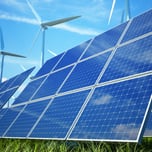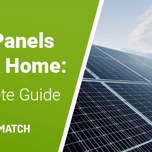Answer these simple questions and we will find you the BEST prices
Which type of solar quotes do you need?
It only takes 30 seconds
100% free with no obligation

Get up to 4 quotes from our selected suppliers by filling in only 1 form

Save money by comparing quotes and choosing the most competitive offer

Our service is 100% free and with no obligation
- GreenMatch
- Green Energy
- Green Energy Grants
- Smart Export Guarantee
Smart Export Guarantee

What Is the Smart Export Guarantee?
In June of 2019, the UK set a goal to reach net-zero carbon emissions by 2050. As part of pursuing that target, on 1 January 2020, the government instituted the Smart Export Guarantee (SEG) scheme. You might have heard of it already, but do you know what it entails and how you can qualify?
The SEG offers export tariffs for a variety of small-scale low-carbon energy generating technologies, as a means to encourage UK homeowners to pursue renewable energy. The Feed-in Tariff ended in 2019, and this new scheme replaces the FIT programme. Whether you already receive FIT payments or are new to renewables, you should learn about the best SEG tariff.
Under the SEG, energy companies will offer you tariffs for the renewable energy you export to the National Grid. You must meet some criteria to receive these tariffs, though. Both of these schemes encourage the uptake of domestic green energy use.
What Do I Need to Qualify for the SEG?
The SEG provides export tariffs for a variety of small-scale, low-carbon energy generation technologies for UK homeowners. Specifically, the SEG covers:
- Solar panels (photovoltaic systems)
- Hydropower
- Wind power
- Anaerobic digestion
- Micro combined heat and power (CHP)
The total capacity for the first four categories cannot exceed 5MW to qualify for the SEG. For Micro CHP, on the other hand, the max is 50kW. No matter what kind of system you have, you also need to have an export meter.
Smart meters make it more convenient for you, as they take measurements every half hour and automatically send the readings to your SEG licensee. If you have to take readings manually, discuss with your licensee how that will work.
Here's a closer look at each one of the included technologies under the SEG.
Solar Photovoltaic Systems
Solar energy is one of the most popular ways to generate low-carbon energy. There are no requirements about what kind of photovoltaic systems you need in order to qualify, as long as they create less than 5MW of electricity. That said, you do need to prove your solar installation is MCS certified.
What that certification looks like varies depending on your energy supplier. Under the SEG, different licensees can choose how they certify installations. To find out what criteria you need to meet, talk to whichever SEG licensee you want to go with.
For systems less than 50kW, you also have to prove your installer is certified. Most domestic solar panel systems fall under this category. The most common sizes are 4kW solar systems, 5kW solar systems, or 6kW solar systems.
If you have a microgeneration certification scheme (MCS) certificate, that will qualify. If not, your installation and installer must have EN 45011 or EN ISO/IEC 17065:2012 accreditation.

How Does the SEG Work With Solar Battery Storage?
If you're familiar with solar power, you probably know about the advantages of solar batteries. Without these storage solutions, you can only use electricity from solar panels during the day. With batteries, however, you can store this energy to use at any time — for example, during the evening when the sun has gone down.
The SEG is an export tariff, so you only get money for what you sell to the grid. If you store your excess solar energy in batteries, you won't get any tariffs for it. This will not lower the solar battery storage price.
However, solar storage is covered by the SEG in some instances, meaning that if you export stored energy you could still qualify for the export tariff. This differs with suppliers, though, so be sure to consult your licensee first.
Hydropower
Hydropower, energy that you generate from water, is another popular choice for renewable electricity. It is far less common than solar power, though. According to Ofgem, hydropower schemes generate 1.5% of the country’s electricity — largely from large-scale systems.
That's not to say you shouldn't pursue these technologies on a domestic level, though. The UK has been a world leader in hydroelectricity for about as long as the technology has been around. If you live in Wales or Scotland, these technologies might be particularly advantageous to you.
If you want SEG tariffs for hydropower, you have to meet the same requirements for solar power of more than 50kW. You need to provide an installation certification, but don't need any such proof regarding your installer. There are no differences in the requirements for hydro systems of less than 50kW.
Wind Power
Wind is the UK's leading renewable power source, accounting for 20% of energy generation in late 2019. Most of it comes from large-scale farms, but you can still use it at home. The equipment may be more expensive than some other options, but it's still a viable option.
As far as qualifications go, wind follows the same rules as solar PV under the SEG. For anything under 50kW, you'll need both an installation and an installer certification. If your system produces between 50kW and 5MW, you will only need to provide proof of the installation certification.
Anaerobic Digestion
Even if you are familiar with renewables, you may not know what anaerobic digestion is. This is the process of breaking down organic material to produce biogas. You can then use this biogas as an energy source that isn't emissions-free but is renewable.
Digesters use microorganisms like bacteria to break down materials like manure, food waste, and wastewater. When these organisms interact with these materials in an oxygen-free environment, they produce natural gas, which is mostly methane. It may be an uncommon process for residential use but is ideal for farmers.
The SEG treats anaerobic digestion the same way it does hydropower. No matter how little you generate, you only need an installation certification. You will, however, need to provide additional documents to prove your system complies with SEG guidelines.
Micro Combined Heat and Power (CHP)
Micro combined heat and power is a system that generates electricity and warmth at the same time. It's not always carbon-free, but since they accomplish these two tasks at once, it reduces emissions. A lot of businesses use CHP since it can significantly reduce both energy costs and environmental impact.
Reciprocating internal combustion engines are one of the most popular micro CHP technologies. Many of these run on natural gas to make them even more environmentally-friendly. Fuel cells are another type of micro CHP, but you don't see them as often.
Micro CHP technologies only qualify for Smart Export Guarantee tariffs if their capacity is 50kW or less. Like with solar and wind power, if your micro CHP system generates less than 50kW, you will need both an installer and an installation certification.
How Much Can You Make Selling Energy Back to the Grid?
Although the SEG is replacing the Feed-in Tariff, it doesn't offer the same rewards for the energy you generate. While the Feed-in Tariff included both export and generation tariffs, the SEG only provides the former. In other words, you only get tariffs for the renewable energy you don't use.
How much you can get through these export tariffs varies depending on your SEG licensee. The Smart Export Guarantee scheme allows companies to decide their own rates, as long as it's more than zero. Currently, you can get between 1-30.31 p per kWh.
| Best SEG rates in the UK | ||
|---|---|---|
| Supplier | SEG Rate (p/kWh) | Customer Only |
| Octopus Energy (Intelligent Flux) | 30.31 (peak) 22.73 (off-peak) | Yes |
| Octopus Energy (Octopus Flux) | 21 | Yes |
| Good Energy (Solar Savings Exclusive) | 20 | Yes |
| So Energy (So Bright) | 20 | Yes |
| OVO SEG Tariff (Exclusive) | 20 | Yes |
| E.ON (Next Export Exclusive) | 16.5 | Yes |
| Good Energy (Solar Savings) | 15 | Yes |
| British Gas (Export and Earn Plus) | 15 | Yes |
| ScottishPower (SmartGen+) | 15 | Yes |
| Octopus (Outgoing Fixed) | 15 | Yes |
| OVO (OVO SEG Tariff) | 15 | Yes |
| ScottishPower (SmartGen) | 12 | No |
| Octopus (Outgoing Fixed Lite) | 8 | Yes |
| British Gas (Export & Earn Flex) | 6.4 | No |
| Rebel Energy (SEG Tariff) | 6 | No |
| Utility Warehouse (UW Smart Export Guarantee) | 5.6 | Yes |
| EDF (Export Variable Value) | 5.6 | Yes |
| Pozitive Energy (SEG tariff) | 5 | No |
| So Energy (So Export Flex) | 4.5 | No |
| Octopus (SEG Tariff) | 4.1 | No |
| Good Energy (Export Only) | 4 | No |
| OVO (SEG Tariff) | 4 | No |
| E.ON (Next Export) | 3 | No |
| Utilita (Utilita Smart Export Guarantee) | 3 | No |
| EDF (Export Variable) | 3 | No |
| Utility Warehouse (UW Smart Export Guarantee - Standard) | 2 | No |
| E (SEG January2020v.1) | 1 | No |
It's important to note that even though you can export solar energy back to the grid at any time of day through the SEG, the payments you receive for transferring energy may differ depending on when the transfer is made.
Some suppliers offer different tariffs for peak and off-peak energy demand hours. This means that in some cases, you may receive more for exporting solar energy in the afternoons, when energy demand is at its highest, than in the morning or at night. That said, many suppliers offer fixed rates regardless of the time of day you transfer energy back to the grid. Be sure to consult your supplier to find out the most up-to-date tariff information.
At 10.8 p/kWh, the average home could earn £75 a year, generating 3,400 kWh, which is around the average household consumption. Combined with your energy bill savings, though, you could save upwards of £1,141 a year overall.
How Do You Apply for the SEG?
Applying for the SEG is not a complicated process. There are a few things you should have collected before submitting your application, though, so spend enough time preparing.
The first thing you need to do in applying is search for a SEG licensee in your area. The SEG licensee can be different than your energy supplier. Since they can offer different rates, you may want to compare a few options.
Before you file any paperwork, make sure you meet all the qualifications. As previously mentioned, some of these vary between licensees, so the process will look different depending on which one you pick.
Prepare all the required information and documents beforehand, namely:
- A smart meter or half-hourly export meter reading. SEG licensees need up-to-date meter readings to process your application.
- Your MCS certification (or equivalent)
- Your proof of ownership. Most licensees stipulate that SEG tariff recipients must be the system owner.
- The application form. This can be found on the SEG licensee’s website.
- For anaerobic digestion, a separate, additional form. This can be found on Ofgem’s website.
Once your application has been submitted, you should expect 28 days of processing time.
Your SEG licensee may have to inspect your system before accepting your application.
Ofgem introduced new customer protection regulations on 15 December 2020 that will support customers that are struggling to pay for their energy bills.
The regulations will protect those that are vulnerable and temporarily unable to pay their energy bills in the form of more appropriate credit management policies and sustainable repayment plans.
FAQ about the Smart Export Guarantee
You may still have questions about the Smart Export Guarantee scheme. If so, here are some FAQs about the programme.
The SEG went into effect on 1 January 2020. Many companies are already offering export tariffs, and more will likely come. Energy suppliers with at least 150,000 domestic customers must provide a tariff, whereas suppliers with fewer customers than that can offer export tariffs on a voluntary basis.
As of May 2020, these are the available SEG suppliers:
- Avro Energy
- British Gas
- Bulb
- E
- EDF Energy
- E.ON
- Green Network
- Green Star Energy (now part of Shell Energy group)
- Npower
- Octopus Energy
- OVO Energy
- Scottish Power
- Shell Energy
- SSE (part of OVO Group)
- Utility Warehouse
- Utilita
- SO Energy
- Symbio Energy
You can check Ofgem’s list of SEG suppliers for any changes.
Each SEG licensee has their own terms and conditions, including the contract duration. While most suppliers have a 12-month fixed contract, some may vary, so it is advised to consult the energy supplier for their terms.
Depending on the SEG licensee, you will receive your payments anywhere from every 3 months to once per year. Each licensee can set their own payment cycles, and it is important to be aware of when payments are made prior to signing an agreement with your energy supplier.
If you currently receive Feed-in Tariff payments, you can continue doing so for the duration of your FIT contract. Since the FIT scheme includes generation tariffs too, you will make more money if you stick with the FIT scheme. Once your agreement is over, you can switch to the SEG.
Some energy suppliers, like Octopus Energy and SO Energy, allow you to keep your FIT generation tariff and only sign on to their SEG export tariff.
Yes, you can receive SEG payments if you received an installation grant from the government. The Smart Export Guarantee is separate from installation grants.
Yes, you can receive both payments at the same time. The SEG supports exporting surplus electricity to the National Grid, while the RHI supports renewable heat generation. You can read more about the RHI in our guide.
Fill in the form in just 1 minute

Emily is a freelance environmental writer who writes on renewable energy, green technology and sustainability. To read more of her writing, you can visit her blog, Conservation Folks, or follow her on Twitter.
We strive to connect our customers with the right product and supplier. Would you like to be part of GreenMatch?










